Tensorflow学习实战之VGG16猫狗大战迁移训练
继续跑深度学习Tensorflow的实战,今天的是VGG16的猫狗大战,整体结构框架由13层卷积和3层全连接层组成,对于对pthon不熟悉的我来说,整个搭建调试过程在于数据的写入处理,维度的变换,以及不同函数的灵活使用。
整个过程,在两个地方卡住,第一个是训练时中途进程中断,修改了不少参数,均没有效果,最终找到的问题是数据集出现了问题,最开始用的是微软官网下载的一个猫狗数据集,后来换数据集之后没有问题。第二个是最后测试的时候出现的问题,载入图片后,总提示维度有问题。
所谓迁移训练呢就是说,在别人训练好的权重基础上呢,进行自己的训练,从而获得适应自己所需任务的模型,结果如下:

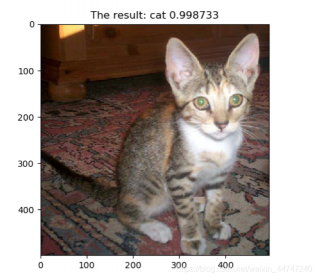
整体的框架是这样的:
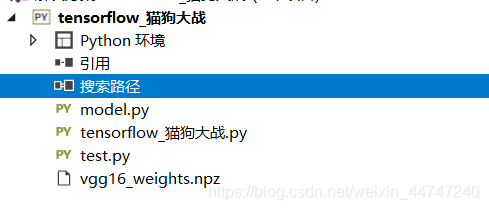
model.py是用来装载搭建的卷积层框架,test.py用来最终结果的预测,猫狗大战用来跑训练,首先来看看16层卷积的搭建吧:
定义卷积、池化、全连接层,然后是搭建一个13层的卷积,和一个三层的全连接层,微调训练过程中,因为最终结果,只需要预测猫狗,class为2,所以只修改了最终一层全连接层,trainable=Ture
import tensorflow as tf
import numpy as np
import os
#模型定义
class vgg16:
def __init__(self, imgs):
#加入全局列表,把所需参数加载进类里
self.parameters=[]
#初始化
self.imgs=imgs
self.convlayers()
self.fc_layers()
#输出类别的概率
self.probs=tf.nn.softmax(self.fc8)
def saver(self):
return tf.train.Saver()
#定义卷积层
def conv(self,name,input_data,out_channel,trainable=False):
#获取通道数
in_channel=input_data.get_shape()[-1]
with tf.variable_scope(name):
#初始化
kernel=tf.get_variable('weights',[3,3,in_channel,out_channel],dtype=tf.float32,trainable=False)
biases=tf.get_variable('baises',[out_channel],dtype=tf.float32,trainable=False)
conv_res=tf.nn.conv2d(input_data,kernel,[1,1,1,1],padding='SAME')
res=tf.nn.bias_add(conv_res,biases)
out=tf.nn.relu(res,name=name)
self.parameters+=[kernel,biases]
return out
#定义全连接层
def fc(self,name,input_data,out_channel,trainable=True):
#获取维度
shape=input_data.get_shape().as_list()
if len(shape)==4:
size=shape[-1]*shape[-2]*shape[-3]
else :size=shape[1]
#数据展开
input_data_flat=tf.reshape(input_data,[-1,size])
with tf.variable_scope(name):
#初始化
weights=tf.get_variable('weights',shape=[size,out_channel],dtype=tf.float32,trainable=trainable)
biases=tf.get_variable('baises',shape=[out_channel],dtype=tf.float32,trainable=trainable)
res=tf.matmul(input_data_flat,weights)
out=tf.nn.relu(tf.nn.bias_add(res,biases))
self.parameters+=[weights,biases]
return out
#定义池化
def maxpool(self,name,input_data):
out=tf.nn.max_pool(input_data,[1,2,2,1],[1,2,2,1],padding='SAME',name=name)
return out
#卷积堆叠
def convlayers(self):
#cov1
self.conv1_1=self.conv('conv1_1',self.imgs,64,trainable=False)
self.conv1_2=self.conv('conv1_2',self.conv1_1,64,trainable=False)
self.pool1=self.maxpool('poolre1',self.conv1_2)
#cov2
self.conv2_1=self.conv('conv2_1',self.pool1,128,trainable=False)
self.conv2_2=self.conv('conv2_2',self.conv2_1,128,trainable=False)
self.pool2=self.maxpool('pool1',self.conv2_2)
#cov3
self.conv3_1=self.conv('conv3_1',self.pool2,256,trainable=False)
self.conv3_2=self.conv('conv3_2',self.conv3_1,256,trainable=False)
self.conv3_3=self.conv('conv3_3',self.conv3_2,256,trainable=False)
self.pool3=self.maxpool('pool3',self.conv3_3)
#cov4
self.conv4_1=self.conv('conv4_1',self.pool3,512,trainable=False)
self.conv4_2=self.conv('conv4_2',self.conv4_1,512,trainable=False)
self.conv4_3=self.conv('conv4_3',self.conv4_2,512,trainable=False)
self.pool4=self.maxpool('pool4',self.conv4_3)
#cov5
self.conv5_1=self.conv('conv5_1',self.pool4,512,trainable=False)
self.conv5_2=self.conv('conv5_2',self.conv5_1,512,trainable=False)
self.conv5_3=self.conv('conv5_3',self.conv5_2,512,trainable=False)
self.pool5=self.maxpool('pool5',self.conv5_3)
#全连接层
def fc_layers(self):
self.fc6=self.fc('fc1',self.pool5,4096,trainable=False)
self.fc7=self.fc('fc2',self.fc6,4096,trainable=False)
#要进行微调,trainable为true
self.fc8=self.fc('fc3',self.fc7,2,trainable=True)
#载入权重
def load_weights(self,weight_file,sess):
weights=np.load(weight_file)
keys=sorted(weights.keys())
for i,k in enumerate(keys):
if i not in[30,31]:
sess.run(self.parameters[i].assign(weights[k]))
print("weights loading......")
接下来是训练过程:
分成了数据集的读取,预处理,通过不同文件夹进行分类,独热编码转换,以及参数设置及进行迭代训练
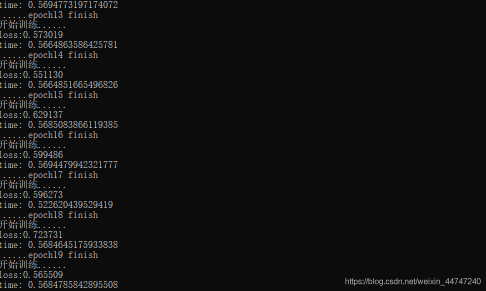
#VGG16
import tensorflow as tf
import numpy as np
import os
from time import time
import utils
import model
#数据输入
def get_file(file_dir):
images=[]
temp=[]
#对不同文件夹分类
for root,sub_folders,files in os.walk(file_dir):
for name in files:
images.append(os.path.join(root,name))
for name in sub_folders:
temp.append(os.path.join(root,name))
labels=[]
for one_folder in temp:
n_img=len(os.listdir(one_folder))
letter=one_folder.split('/')[-1]
if letter=='Cat':
labels=np.append(labels,n_img*[0])
else :
labels=np.append(labels,n_img*[1])
temp=np.array([images,labels])
temp=temp.transpose()
np.random.shuffle(temp)
image_list=list(temp[:,0])
label_list=list(temp[:,1])
label_list=[int(float(i)) for i in label_list]
return image_list,label_list
def get_batch(image_list,label_list,img_width,img_height,batch_size,capacity):
image=tf.cast(image_list,tf.string)
label=tf.cast(label_list,tf.int32)
input_queue=tf.train.slice_input_producer([image,label])
label=input_queue[1]
image_contents=tf.read_file(input_queue[0])
image=tf.image.decode_jpeg(image_contents,channels=3)
image= tf.image.resize_images(image, [224, 224], method=tf.image.ResizeMethod.NEAREST_NEIGHBOR)
image_batch,label_batch=tf.train.batch([image,label],batch_size=batch_size,num_threads=64,capacity=capacity)
label_batch=tf.reshape(label_batch,[batch_size])
return image_batch,label_batch
#转换独热编码
def onehot(labels):
n_sample=len(labels)
n_class=max(labels)+1
onehot_labels=np.zeros((n_sample,n_class))
onehot_labels[np.arange(n_sample),labels]=1
return onehot_labels
batch_size=10
capacity=256#存储容量
#VGG预训练是减掉的均值
means=[123.68,116.779,103.939]
img_width=224
img_height=224
start_time=time()
xs,ys =get_file('D:/demo/tensorflow_猫狗大战/tensorflow_猫狗大战/data/')
image_batch,label_batch=get_batch(xs,ys,img_width,img_height,batch_size,capacity)
print(len(xs),len(ys))
x=tf.placeholder(tf.float32,[None,224,224,3])
y=tf.placeholder(tf.int32,[None,2])
vgg=model.vgg16(x)
fc8_finetuining=vgg.probs
loss_function=tf.reduce_mean(tf.nn.softmax_cross_entropy_with_logits(logits=fc8_finetuining,labels=y))
optimizer=tf.train.GradientDescentOptimizer(learning_rate=0.001).minimize(loss_function)
sess=tf.Session()
sess.run(tf.global_variables_initializer())
vgg.load_weights('vgg16_weights.npz',sess)
saver=tf.train.Saver()
coord= tf.train.Coordinator()
threads=tf.train.start_queue_runners(coord=coord,sess=sess)
epoch_start_time=time()
for i in range (100):
print('开始训练......')
images,labels=sess.run([image_batch,label_batch])
labels=onehot(labels)
sess.run(optimizer,feed_dict={x:images,y:labels})
loss=sess.run(loss_function,feed_dict={x:images,y:labels})
print("loss:%f"%loss)
epoch_end_time=time()
print('time:',(epoch_end_time-epoch_start_time))
epoch_start_time=epoch_end_time
if(i+1)%20==0:
saver.save(sess,os.path.join('./model/','epoch{:06d}.ckpt'.format(i+1)))
print("____epoch%d finish"%(i+1))
saver.save(sess,'./model/')
print('finish,alltime:',time()-start_time())
coord.request_stop()
coord.join(threads)
最后是检测部分的函数。
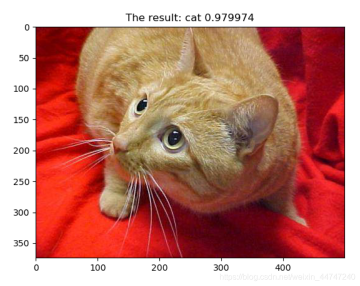
import tensorflow as tf
import numpy as np
from imageio import imread
import model as model
from PIL import Image
import matplotlib.pyplot as plt
tf.reset_default_graph()
means=[123.68,116.779,103.939]
x=tf.placeholder(tf.float32,[None,224,224,3])
with tf.Session() as sess:
vgg=model.vgg16(x)
fc8_finetuining=vgg.probs
saver=tf.train.Saver()
print('restoring...')
saver.restore(sess,'./model/')
filepath='./1116.jpg'
image_raw_data = tf.gfile.FastGFile(filepath,'rb').read()
img_data = tf.image.decode_jpeg(image_raw_data)
plt.imshow(img_data.eval())
image = tf.image.resize_images(img_data, [224, 224], method=tf.image.ResizeMethod.NEAREST_NEIGHBOR)
img = image.eval()
print(img.shape)
image = tf.expand_dims(image,0)
print(image.shape)
#for c in range(3):
# image[:,:,c] -= means[c]
prob=sess.run(fc8_finetuining,feed_dict={x:[img]})
max_index=np.argmax(prob)
if max_index==0:
plt.title('The result: cat %.6f'%prob[:,0])
plt.show()
else:
plt.title('The result: dog %.6f'%prob[:,1])
plt.show()
全程手敲,几近崩溃,趁年轻读点书,不想做小工了,算了不说了,我今晚还有两车砖要搬…
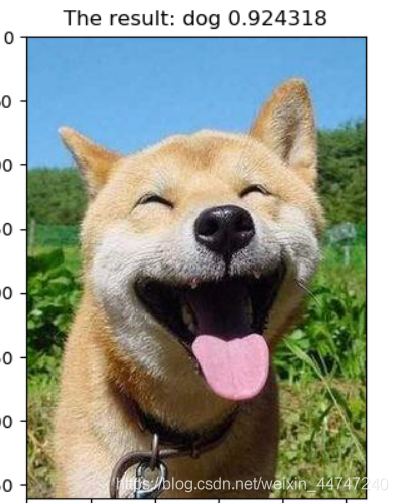






评论(1)
您还未登录,请登录后发表或查看评论